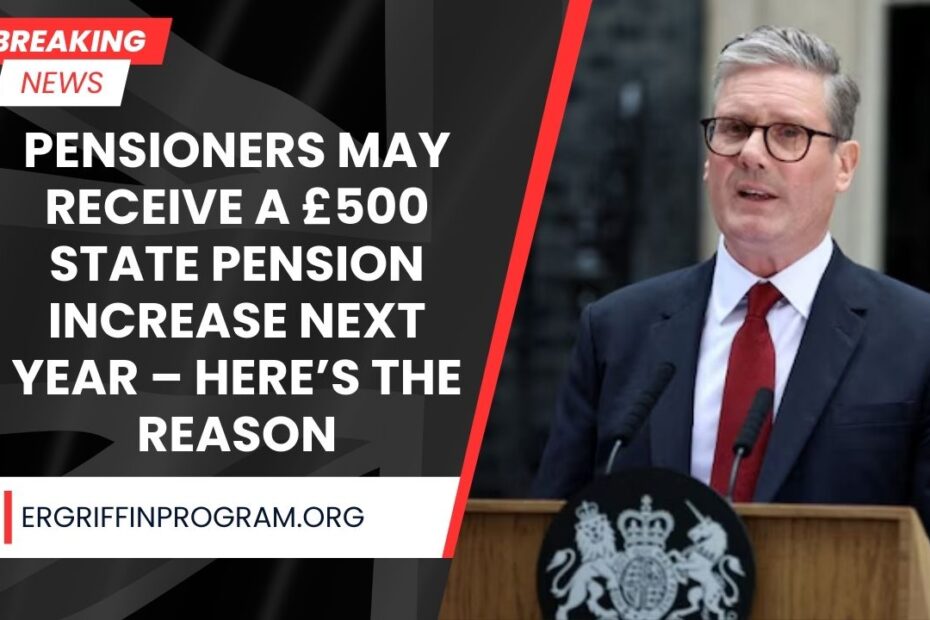Pensioners across the UK may be looking at an unexpected windfall next year—with forecasts pointing to a state pension rise of around £500 annually.
This anticipated increase stems from the government’s triple lock system, which ensures pension payments rise by the highest measure among inflation, wages, or a minimum of 2.5%.
In this article, we break down why this rise is happening, what it means for pensioners, how taxation plays a role, and what actions retirees should consider now.
What Is Driving the £500 Increase? The Triple Lock Mechanism
The triple lock ensures the state pension increases each April by whichever is highest among:
- Inflation
- Average wage growth
- A guaranteed 2.5% floor
For the 2026/27 tax year, wage growth is expected to outpace inflation, estimated around 4–4.5%. That suggests an uplift of roughly £479 to £539 annually on the current £11,973 yearly new state pension—translating to about £12,451 to £12,512 in total before tax.
This equates to around £500 more per year, hence the buzz about pensioners receiving a £500 boost.
Numbers at a Glance: How Much Could the Pension Increase?
Here’s a snapshot:
| Item | Current/New State Pension (2025/26) | Forecast Rise (2026/27) | Post–Increase Total |
|---|---|---|---|
| Annual Benefit | £11,973 | +£478 to £539 | ~£12,451 to £12,512 |
| Weekly Benefit | £230.25 (Full new pension) | +£9.22 to £10.38 | ~£239 to £240 per week |
| Primary Driver | — | Wage growth ~4–4.5% | — |
| Taxation Threshold | £12,570 (Personal Allowance) | — | Pension may breach threshold |
Who Benefits—And Who Might Be Taxed?
If the state pension rises to around £12,460–£12,510 annually, it’s likely to exceed the personal allowance of £12,570, or at least come close.
That means pensioners with even modest additional income—from part-time work, private pensions, or other sources—might begin paying income tax on a portion of their pension income for the first time.
This “fiscal drag” is a growing concern among retirees.
Broader Financial and Fiscal Implications
- Cost to Government: The projected rise, estimated at £478 annually, would cost the exchequer around £2.1 billion, intensifying pressure amid a £50 billion budget deficit.
- Tax Burden Shifts: With frozen income tax thresholds and rising pensions, policymakers warn more pensioners will be drawn into the tax net—even if their incomes haven’t truly increased in real terms.
- Calls for Reform: Critics argue that while the triple lock supports pensioner incomes, it may be unsustainable long-term given economic strain and demographic changes.
What This Means for Pensioners
Claiming Pension Credit
Those with lower total incomes may be eligible for Pension Credit, a benefit designed to top up state pension payments for retirees on limited incomes.
It can also unlock additional help, like help with housing costs, heating, council tax rebates, and free TV licences for those over 75.
Deferring Pension Claims
Delaying (deferring) claiming your state pension can result in higher future payments, offering a useful strategy to manage tax consequences or income thresholds.
Reviewing National Insurance Gaps
Checking and possibly buying missing years of National Insurance contributions can bolster your entitlement to a fuller state pension.
Key Facts & Figures
| Aspect | Details |
|---|---|
| Triple Lock Drivers | Inflation, wage growth (~4–4.5%), or 2.5% minimum |
| Current Annual Pension | £11,973 |
| Expected Rise | £478 – £539 |
| Projected New Pension | ~£12,451 – £12,512 |
| Personal Allowance (Tax-Free) | £12,570 |
| Tax Implication | Possible new income tax liability for some pensioners |
| Government Cost | Approx. £2.1 billion increase |
| Risks | Fiscal drag, sustainability concerns |
| Helpful Actions | Claim Pension Credit, defer pension, fill NI gaps |
Why This Matters—Key Takeaways
- Significant Increase: A potential £500 annual boost is a meaningful improvement for pensioner finances.
- Tax Complexity: Potential tax implications mean it’s not just about the increase—net gain may be less, depending on other income.
- Policy Sustainability: The combination of triple lock and frozen tax thresholds is creating structural challenges that likely need reform.
- Proactive Planning: Pensioners should review their income situation, explore benefits eligibility, and potentially defer claims to optimize overall outcomes.
The prospect of a £500 increase in the UK state pension for the 2026/27 tax year is a welcome development for many retirees.
Thanks to the triple lock, pensions are likely to rise in line with robust wage growth—though this also risks pushing many into the tax net due to frozen thresholds.
Pensioners should carefully assess the net benefit, explore Pension Credit, consider deferral strategies, and review their NI contribution record.
Amid ongoing fiscal challenges, proactive retirement planning has never been more crucial.
Frequently Asked Questions
1. Could I really see a £500 increase in my state pension next year?
Yes. Forecasts suggest the annual state pension could rise from £11,973 to around £12,451–£12,512, a potential gain of £478–£539, thanks to the triple lock mechanism tied to rising wages.
2. Will I have to pay more tax because of the increase?
Possibly. As the rise pushes pension income closer to or beyond the £12,570 personal allowance, pensioners with even small extra income may become taxable on some of their state pension—especially concerning if thresholds remain frozen.
3. What can I do to avoid paying more tax or maximise my pension benefits?
You can consider:
- Deferring your pension, which raises your future payouts.
- Claiming Pension Credit, if your income is low, to top up state pension and gain additional benefits.
- Filling National Insurance contribution gaps, if eligible, to increase future pension entitlement.



